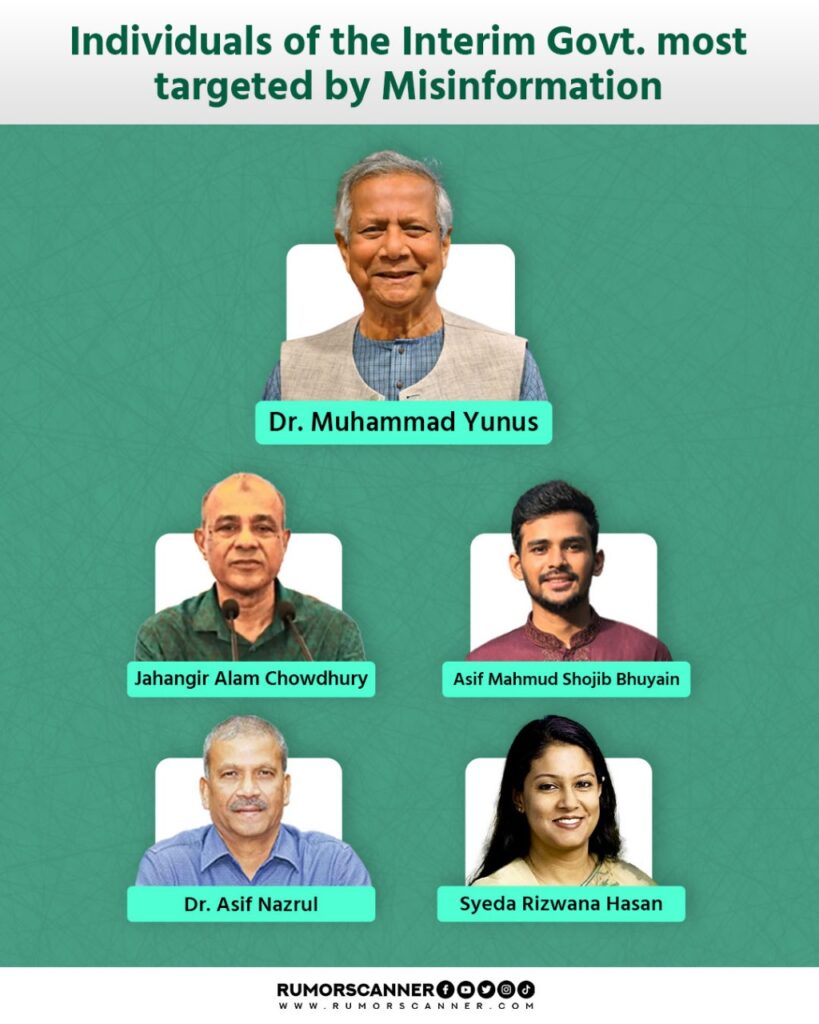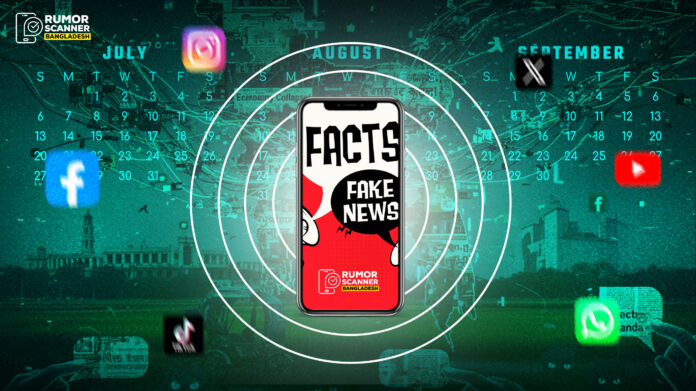- In the third quarter (July-September), 959 pieces of misinformation were identified.
- Over nine months, 2,754 pieces of misinformation were detected.
- Political disinformation increased by 69 percent in the third quarter.
- Among political parties, the Awami League and, individually, Sheikh Hasina’s name were most associated with disinformation.
- The highest amount of disinformation on a single issue was related to the DUCSU election.
- 72 pieces of misinformation involved the army, and 59 involved the police.
- While communal disinformation has increased, there is stability in the propaganda from Indian media.
- In 72 incidents, 28 media outlets were linked to 73 pieces of disinformation.
In the third quarter of this year (July to September), Rumor Scanner identified 959 pieces of misinformation circulating in Bangladesh, which is approximately 13 percent higher than the same period last year. Political disinformation was the most prevalent, accounting for about 64 percent of the total misinformation identified in this quarter. In total, over the past nine months, Rumor Scanner detected 2,754 pieces of misinformation circulating in Bangladesh, a 24 percent increase compared to the same period last year. The use of artificial intelligence to spread disinformation has increased, and a continuous flow of disinformation has been observed around various events. These findings were derived from analyzing fact-checks and other reports published by Rumor Scanner in the third quarter.
Severity of Political Disinformation
With the 13th national parliamentary election scheduled for February 2026, the political landscape is currently abuzz with various issues. Statistics indicate that this has also fueled a surge in disinformation. In the third quarter of this year, there has been an explosion of political disinformation. While 710 pieces of political disinformation were identified in the first two quarters, the third quarter alone recorded 615 pieces, marking a 69 percent increase compared to the second quarter.
Over the past three months, several events have contributed to this trend. Notable incidents include the murder of scrap trader Sohag in Mitford, Dhaka on July 9; the NCP’s march in Gopalganj on July 16; Jamaat-e-Islami’s rally in Dhaka on July 19; a strike called by four Awami League-affiliated organizations on July 20; the death anniversary of Sheikh Mujibur Rahman on August 15; stone looting incidents in Sylhet; clashes between Jatiya Party and Gono Odhikar Parishad in Dhaka on August 29; the Dhaka University Central Students’ Union (DUCSU) election on September 9; and the Jahangirnagar University Central Students’ Union (JUCSU) election on September 11. Among these, the DUCSU election stood out as the single issue with the highest number of disinformation cases, with Rumor Scanner identifying 52 rumors. Additionally, 38 pieces of disinformation were linked to the NCP’s march in Gopalganj, and 21 were related to Sheikh Mujibur Rahman’s death anniversary.
The impact of this disinformation surge has affected political parties. Compared to the first quarter, disinformation involving all major political parties increased in the third quarter. The most significant rise was observed for the Bangladesh Nationalist Party (BNP) and the National Citizen’s Party (NCP). Disinformation involving the BNP increased by approximately 180 percent in the third quarter compared to the first quarter, while for the NCP, the increase was even higher, at around 204 percent.
In the third quarter of this year, the majority of disinformation circulating in Bangladesh’s political sphere was linked to the Bangladesh Awami League, a party currently banned from organizational activities. Rumor Scanner identified 283 pieces of disinformation involving the party, its affiliated and sister organizations, and its leaders and activists over the past three months. Of these, 110 pieces of disinformation were directly associated with the Awami League as a party. Analysis shows that approximately 94 percent of this disinformation was framed to create a positive perception of the party. During this period, the highest number of disinformation cases (63) involved the party’s president, Sheikh Hasina, with about 97 percent of these presenting her in a positive light.
In the third quarter, the second-highest number of disinformation cases (151) was linked to the Bangladesh Nationalist Party (BNP). Of the 66 pieces of disinformation directly involving the party, around 94 percent were framed to create a negative perception of the BNP. During this time, 10 pieces of disinformation were identified involving BNP Secretary General Mirza Fakhrul Islam Alamgir, with approximately 90 percent presenting him negatively. Additionally, nine pieces of disinformation were linked to BNP’s acting chairman, Tarique Rahman, with about 78 percent portraying him negatively.
Over the past three months, Rumor Scanner identified 126 pieces of disinformation involving Bangladesh Jamaat-e-Islami, its affiliated organizations, and its leaders and activists. Of these, 48 pieces were directly associated with the party, with approximately 93 percent framed to create a negative perception of Jamaat. During this period, the party’s Ameer, Dr. Shafiqur Rahman, was targeted in two disinformation cases, all of which presented him negatively.
Additionally, 73 pieces of disinformation were identified involving the National Citizen’s Party (NCP) in the third quarter. Of these, 33 pieces were directly linked to the party, all of which presented the NCP negatively. During this time, Rumor Scanner identified four pieces of disinformation involving the party’s convener, Nahid Islam, all of which portrayed him negatively.
Misinformation on National and International Issues Has Decreased
While the flow of disinformation on political issues has been steadily increasing this year, the situation for national issues shows exactly the opposite trend. From the first quarter to the third quarter, the flow of misinformation on national issues has consistently decreased. This decline amounts to approximately 27 percent compared to the first quarter and about 16 percent compared to the second quarter.
In the third quarter, at least two major events have played a significant role in the spread of disinformation in the national sphere. Specifically, 39 pieces of disinformation were identified related to the crash of an Air Force plane at Milestone School and College in Uttara, Dhaka on July 21, and 20 pieces of disinformation were linked to incidents of violence in Khagrachhari.
The rate of misinformation on international issues has also significantly decreased in the third quarter. Compared to the second quarter, the decline in misinformation is approximately five and a half times higher. This reduction is attributed to a decrease in global issue-based events. While the second quarter saw an increase in misinformation due to events such as the genocide in Gaza by Israel, Pakistan-India conflicts, and Iran-Israel tensions, no such significant global issues were observed in the third quarter, resulting in a corresponding decrease in misinformation.
On the other hand, the flow of disinformation on religious issues, particularly surrounding the Hindu festival of Durga Puja, increased in the third quarter. Similarly, misinformation related to sports, particularly centered around the Asia Cup cricket tournament, was also observed. However, while the spread of disinformation involving celebrities in the entertainment sector increased in the second quarter, it has shown a decline over the last three months.
Interim Government Regularly Targeted by Disinformation
Following the fall of the Awami League government amid a mass movement, the interim government led by Dr. Muhammad Yunus assumed power on August 8 last year. Since taking office, individuals associated with the government have been consistently targeted by disinformation. In the third quarter, Rumor Scanner identified 77 pieces of disinformation involving the government and its top officials. However, this number was higher in the first and second quarters, with 128 and 121 pieces of disinformation, respectively.
In the third quarter, the amount of misinformation targeting Chief Adviser Dr. Yunus also decreased. While 50 pieces of misinformation were circulated about him from January to March and 62 in the subsequent three months, this number dropped to 37 in the third quarter.

In addition to Dr. Muhammad Yunus, nine other advisers of the interim government were targeted by misinformation in the third quarter, with a total of 25 pieces identified. Among them, Jahangir Alam Chowdhury was linked to nine pieces, Asif Mahmud Shojib Bhuyain to five, Dr. Asif Nazrul to four, Syeda Rizwana Hasan to two, and Mahfuj Alam, Dr. Salehuddin Ahmed, Chowdhury Rafiqul Abrar, Faruk-e-Azam, and Bidhan Ranjan Roy Poddar were each associated with one piece of misinformation.
Armed Forces and Police Targeted by Disinformation
Rumor Scanner found evidence of 179 pieces of misinformation involving Bangladesh’s armed forces and law enforcement agencies in the third quarter of this year, marking an increase of approximately 4 percent compared to the second quarter. The Bangladesh Army was the most targeted, with 72 pieces of misinformation identified. Rumor Scanner also identified 19 pieces of disinformation involving the current army chief, General Waker-uz-Zaman, over the past three months.
Additionally, 59 pieces of misinformation targeting the Bangladesh Police were identified during this period, representing a staggering 228 percent increase compared to the second quarter. One piece of misinformation was identified involving the Inspector General of Police (IGP), Baharul Alam, between July and September this year.
Beyond this, Rumor Scanner identified 13 pieces of misinformation involving the Bangladesh Air Force, two involving the Bangladesh Navy, four involving the Rapid Action Battalion (RAB), and six involving the Border Guard Bangladesh (BGB) over the three-month period.
AI-Generated and Edited Photocards in Election-Related Disinformation
The government has already indicated that the national election is likely to take place in the first half of February 2026. In this context, the spread of disinformation has been notable. Over the past three months, 25 pieces of election-related disinformation were identified, although this represents a 55 percent decrease compared to the second quarter. Of the election-related disinformation identified in the third quarter, eight pieces were propagated using fake or edited photocards. Over the past few years, photocards attributed to media outlets have become a powerful and widely used medium for spreading disinformation in Bangladesh. These often include the names, logos, and associated elements of media organizations to propagate disinformation regularly. In the third quarter of this year, Rumor Scanner identified 73 pieces of disinformation across 72 incidents involving 28 domestic and foreign media outlets, using their names, logos, headlines, and fake or forged photocards. Mainstream media outlets Jamuna TV and Kalbela were the most frequently misused, with their names used in 10 instances each. Kaler Kantho and Amader Desh followed with seven instances each, while Channel 24, Ekattor TV, and Dhaka Post were each linked to four instances.
The use of artificial intelligence (AI) in spreading disinformation has been regularly observed, particularly in election-related issues. In the third quarter, four pieces of election-related disinformation involving AI were identified. However, the misuse of AI is not limited to elections; it has been observed across various domains. In the third quarter, a total of 123 pieces of misinformation were identified where AI technology was used. During the same period, 18 deepfake videos were also detected.
Control Over Communal Disinformation and Indian Media Propaganda
The issue of communal disinformation has been a topic of discussion for the past few months. In the third quarter of this year, Rumor Scanner identified 36 pieces of communal disinformation, compared to 28 in the second quarter. Of the communal disinformation identified in the past three months, 20 cases were traced to accounts and pages with Indian identities on social media platforms.
Additionally, in the third quarter, five pieces of disinformation related to Bangladesh were propagated by 31 Indian media outlets across five incidents. India TV topped the list, being responsible for three pieces of disinformation.
Flood of Misinformation on Meta Platforms
While the rate of misinformation on Facebook slightly decreased in the third quarter compared to the second quarter, the spread of misinformation on Instagram surged by approximately two and a half times during the same period. Similarly, the rate of misinformation detection on TikTok increased by about three and a half times. This upward trend was also observed on X, while the rate of misinformation on the video streaming platform YouTube remained largely stable.
Beyond social media platforms, local media in Bangladesh also played a role in spreading misinformation. Over the past three months, 51 fact-checks involving misinformation, images, and videos were conducted on local media, which is higher than in the previous two quarters. Additionally, during the same period, Indian media propagated at least five pieces of disinformation related to Bangladesh across five incidents.
An analysis of the reports published by Rumor Scanner in the third quarter of this year (July to September 2025) reveals that 673 pieces of misinformation involving completely false or fabricated events were identified. Additionally, 189 pieces were rated as misleading, and 96 were classified as distorted. One instance of a humorous or sarcastic event misrepresented as a factual claim was also fact-checked. In the process of identifying this misinformation, 225 pieces of text, 130 images, and 604 videos were verified.
Methodology
This data is based on reports published on Rumor Scanner’s website from July to September 2025. For the purpose of compiling these statistics, data from each report over the past three months was systematically collected and documented. The data was then analyzed and compared with the first two quarters of the year. Subsequently, the findings were presented through infographics and written reports.






